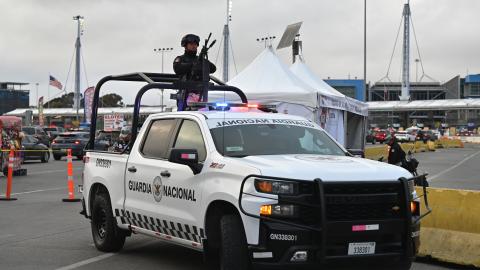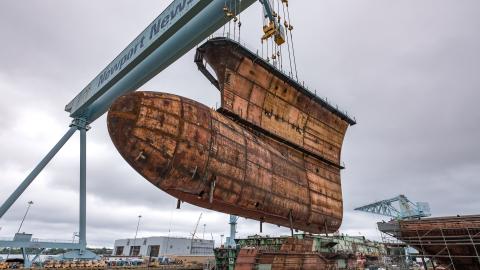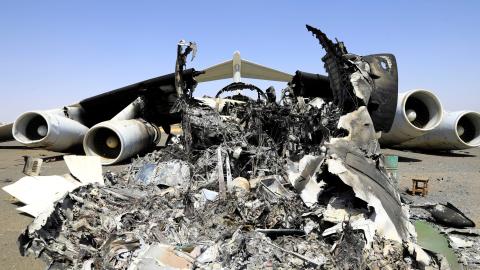Last week’s Chinese-U.S. presidential summit yielded no evident progress on North Korea — the most immediate threat to U.S. security. Beijing will not soon save us from Pyongyang’s nuclear-armed missiles, which are becoming more deadly with each passing month. The Trump administration is considering arming South Korea with nuclear weapons or trying to assassinate Kim Jung-un but a wiser path would be to reinforce U.S. defenses against North Korean missiles.
This past year, North Korea conducted two nuclear weapons tests, launched dozens of ballistic missiles, and recently tested a solid-fueled mobile missile that can likely launch from an unknown location in minutes, excluding preemptive options. Pyongyang is developing missiles able to reach the United States. As Senator Dan Sullivan said last week, “That's going to happen” so we had better prepare.
Iranian missile threats to the United States and its allies also persist. This month’s Iranian presidential elections could see anti-American hardliners gain even more power. The 2014 nuclear deal does not cover missiles, while Tehran is ignoring UN resolutions prohibiting such tests. North Korea and Iran have colluded for years to enhance each other’s missile capabilities.
The current fleet of Ground Based Interceptors (GBIs) offers the only way of protecting the continental United States from these missiles. They rely on a proven hit-to-kill technology, colliding in space with incoming warheads and missiles.
Unfortunately, the few dozen GBIs now deployed in Alaska and California were rushed into service in the early 2000s to deal with emerging threats after the September 2001 terrorist attacks. They have performed poorly in tests due to their aging technologies, which date from the 1990s, patched upgrades, and infrequent tests.
Now we have an opportunity to comprehensively upgrade our missile defense arsenal through a planned Redesigned Kill Vehicle (RKV) for the GBIs, which will apply the new technologies and best practices developed for missile defenses during the past two decades. Specifically, the RKV will apply mature components in a modular open architecture to simplify design, improve reliability, and reduce costs.
These capabilities have been evident in the success of other U.S. missile defense systems, such as the Aegis-equipped warships with the Standard Missile, whose latest version, the SM-3 IIA, had its first effective intercept test in February. The RKV will draw on the SM program’s improved flight-to-ground “talk-back” communications, sensor capabilities, improved data processing, and better target discrimination — achieving performance improvements at low cost.
The Defense Department will raise the reliability of the interceptors by testing them more frequently and in more demanding scenarios — as well as through modernization of sensors, a new long-range radar based in Alaska, and enhancing other critical infrastructure.
The Pentagon will expand the capacity and capability of the GBIs using a modular design that is more easy to build due to its fewer parts. Failing or obsolete components can be replaced without redesigning the entire kill vehicle. This open-architecture approach opens the RKV’s development to more competition since modularization removes the need to be locked into a single contractor. The RKV will also make the GBI fleet more uniform by upgrading most interceptors to a common higher standard.
This modularity also means that the RKV will be easier to maintain, upgrade, and manufacture — controlling costs. Affordability is critical for sustaining enduring improvements in U.S. missile defenses. For example, the high cost of the existing GBI fleet means that the Pentagon tests the current fleet infrequently — the test scheduled for this May will be the first in three years. The Pentagon will avoid past problems by testing the RKV extensively, in diverse ways, before deploying it.
The Trump administration’s impending Missile Defense Review and more flexible congressional legislation empowers the Pentagon to pursue these homeland defense goals with new flexibility. The plan is to complete development of the RKV in the next few years, with increasing complex flight tests; start deployment in 2020, and replace most GBIs by 2027.
Although developing novel technologies is always difficult, the evolutionary approach leverages proven methods developed over some 20 years of testing. The most technological reliable and cost-effective method is to reengineer what already exists. Still, realizing these gains on schedule requires adequate funding and effective public-private partnerships.
Deploying and testing the RKV will in turn facilitate developing the Multi-Object Kill Vehicle, which aims to have the capacity to intercept more than one target at a shot, and more advanced directed-energy or space-based technologies in coming decades.
Yet, for the next few years, achieving revolutionary technological breakthroughs is unlikely. Our best bet is to rapidly deploy the RKV to keep ahead of emerging North Korean and other missile threats in balance with other deterrence and defense enhancements.
















